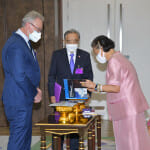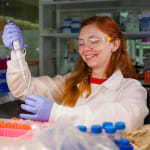Tag Research
New atomic-scale understanding of catalysis could unlock massive energy savings
Catalyst materials are critical for refining petroleum products and for manufacturing pharmaceuticals, plastics, food additives, fertilizers, green fuels, industrial chemicals and much more.
Science Journalist in Residence meets UW’s creatures
Last week, in addition to visiting students in classrooms and sharing their passion for writing about creatures in a public panel, science journalist Sabrina Imbler visited several labs across UW–Madison to meet researchers and critters alike.
DOE renews funding for Great Lakes Bioenergy Research Center; UW–Madison hub to receive $27.5 million for 2023
The extension will allow GLBRC scientists to continue foundational research to enable the breakthroughs needed for the cost-effective conversion of non-food plants into low-carbon replacements for jet fuel, diesel and other fossil fuels.
Earlier algae blooms, lingering toxins: Invasive species cause big changes to a lake’s microbial community
Two invasive species are having an outsized impact on toxic algae blooms according to a recent study from UW–Madison, which shows that algal toxins stay in water longer thanks to the combined effects of invasive species on Lake Mendota's microbial community.
Research in the Rotunda: From plastics recycling to imposter phenomenon
Several UW–Madison students shared their research in the Wisconsin State Capitol on March 8, in the annual "Research in the Rotunda" event.
From concussions to PFAS: five ways UW research is tackling real-world problems
From advanced materials aimed at making athletes safer to medical discoveries that could one day help treat ailments like blindness, here are just a few examples.
Royal visit strengthens WIPAC and IceCube’s partnership with Thailand
Discussions between scientists and Her Royal Highness Princess Maha Chakri Sirindhorn explored how to increase research opportunities for Thai researchers and technical staff at the IceCube Neutrino Observatory.
Smooth sailing for electrons in graphene
Physicists at the University of Wisconsin–Madison directly measured, for the first time at nanometer resolution, the fluid-like flow of electrons in graphene.
New UW institute to study evidence-based solutions to diversity-related challenges
The new Institute for Diversity Science will be a hub for studying the discrimination and evaluating solutions.
Seed strategy can help restore a biodiversity hotspot
Seeding longleaf pine understories with a mix of native savanna species could help restore one of North America's most biodiverse ecosystems.
Weight loss may be early predictor of Alzheimer’s disease in Down syndrome
The findings indicate weight loss may be a useful predictor of the disease prior to the onset of the cognitive problems that often trigger diagnosis.
Teaching Indigenous land dispossession in Wisconsin and beyond
Thanks to new funding from the National Endowment for the Humanities, an interdisciplinary group of UW–Madison faculty, staff and graduate students will be able to help teach the history of land taken from tribal nations to benefit land-grant universities.
A blood test for cancer shows promise thanks to machine learning
UW–Madison researchers have developed a method for early cancer detection using blood plasma, machine learning and equipment commonly found in medical labs.
First-in-kind psychedelic trials treat opioid and methamphetamine use disorders
School of Pharmacy and School of Medicine and Public Health collaborators are leading two first-in-kind clinical psilocybin trials for treating opioid and methamphetamine use disorders.
Lab-grown retinal eye cells make successful connections, open door for clinical trials to treat blindness
The most common retinal cell types forming synapses were photoreceptors – rods and cones – which are lost in diseases like retinitis pigmentosa and age-related macular degeneration, as well as in certain eye injuries.
Northeastern Wisconsin PFAS plume moves into Green Bay via groundwater
Researchers have "fingerprinted" PFAS chemicals in the waters of Green Bay, linking them to upstream to their likely source and downstream to farm fields.
Drying process could be key step in the development of life
New research could help explain crucial early steps on the path of life that led from a pool filled with simple amino acids to bacteria, redwood trees and people.




















